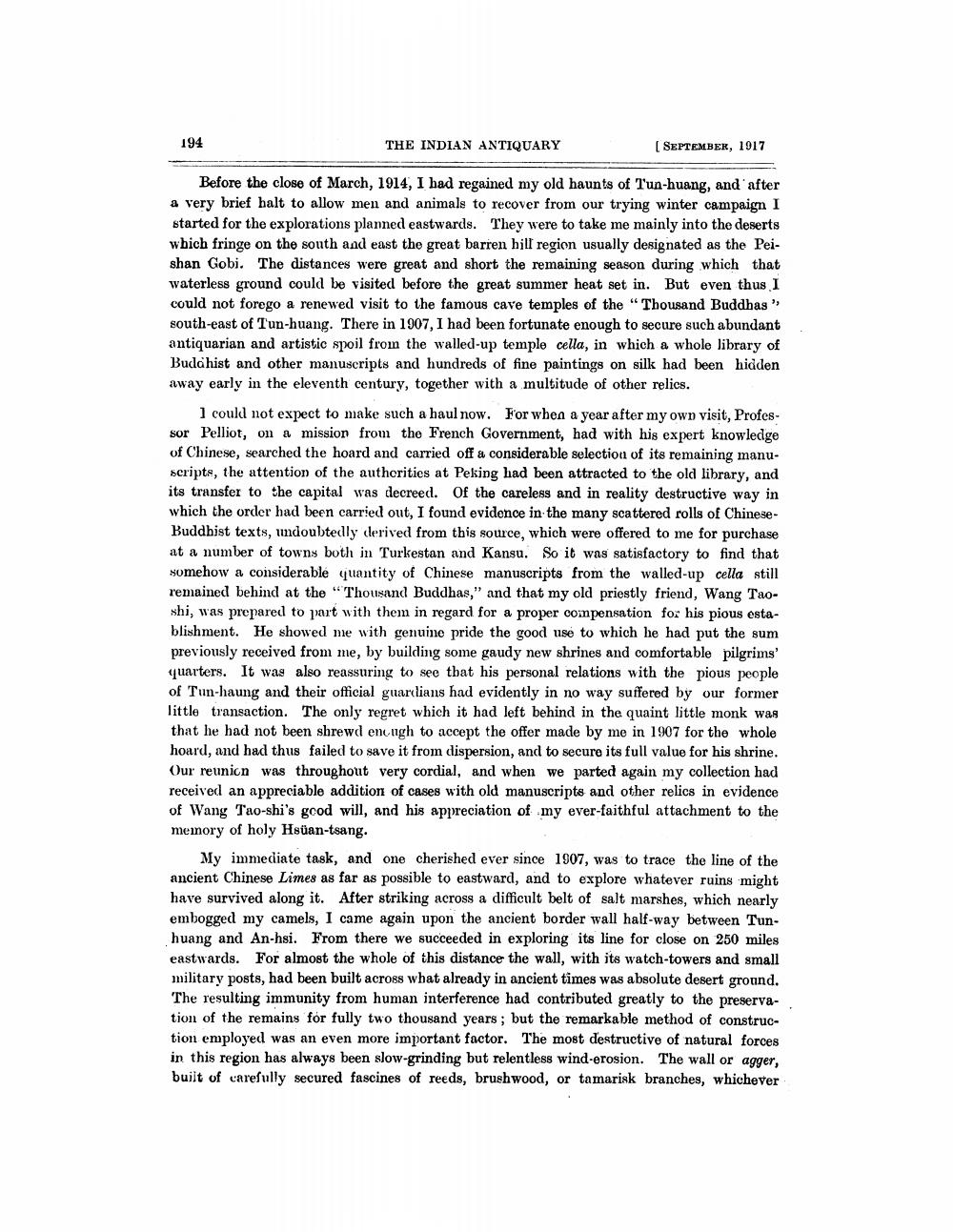________________
194
THE INDIAN ANTIQUARY
[ SEPTEMBER, 1917
Before the close of March, 1914, I had regained my old haunts of Tun-huang, and after a very brief halt to allow men and animals to recover from our trying winter campaign I started for the explorations planned eastwards. They were to take me mainly into the deserts which fringe on the south and east the great barren hill region usually designated as the Peishan Gobi. The distances were great and short the remaining season during which that waterless ground could be visited before the great summer heat set in. But even thus I could not forego a renewed visit to the famous cave temples of the "Thousand Buddhas" south-east of Tun-huang. There in 1907, I had been fortunate enough to secure such abundant antiquarian and artistic spoil from the walled-up temple cella, in which a whole library of Buda hist and other manuscripts and hundreds of fine paintings on silk had been hidden away early in the eleventh century, together with a multitude of other relics.
I could not expect to make such a haul now. For when a year after my own visit, Professor Pelliot, on a mission from the French Government, had with his expert knowledge of Chinese, searched the hoard and carried off a considerable selection of its remaining manuscripts, the attention of the authorities at Peking had been attracted to the old library, and its transfer to the capital was decreed. Of the careless and in reality destructive way in which the order had been carried out, I found evidence in the many scattered rolls of ChineseBuddhist texts, undoubtedly derived from this source, which were offered to me for purchase at a number of towns both in Turkestan and Kansu. So it was satisfactory to find that somehow a considerable quantity of Chinese manuscripts from the walled-up cella still remained behind at the "Thousand Buddhas," and that my old priestly friend, Wang Taoshi, was prepared to part with them in regard for a proper compensation for his pious ostablishment. He showed me with genuine pride the good use to which he had put the sum previously received from me, by building some gaudy new shrines and comfortable pilgrims' quarters. It was also reassuring to see that his personal relations with the pious people of Tun-haung and their official guardians had evidently in no way suffered by our former little transaction. The only regret which it had left behind in the quaint little monk was that he had not been shrewd enough to accept the offer made by me in 1907 for the whole hoard, and had thus failed to save it from dispersion, and to secure its full value for his shrine. Our reunion was throughout very cordial, and when we parted again my collection had received an appreciable addition of cases with old manuscripts and other relics in evidence of Wang Tao-shi's good will, and his appreciation of my ever-faithful attachment to the memory of holy Hsüan-tsang.
My immediate task, and one cherished ever since 1907, was to trace the line of the ancient Chinese Limes as far as possible to eastward, and to explore whatever ruins might have survived along it. After striking across a difficult belt of salt marshes, which nearly embogged my camels, I came again upon the ancient border wall half-way between Tunhuang and An-hsi. From there we succeeded in exploring its line for close on 250 miles eastwards. For almost the whole of this distance the wall, with its watch-towers and small military posts, had been built across what already in ancient times was absolute desert ground. The resulting immunity from human interference had contributed greatly to the preservation of the remains for fully two thousand years; but the remarkable method of construction employed was an even more important factor. The most destructive of natural forces in this region has always been slow-grinding but relentless wind-erosion. The wall or agger, built of carefully secured fascines of reeds, brushwood, or tamarisk branches, whichever




